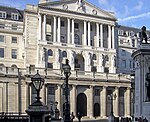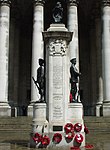St Margaret Lothbury
17th-century Church of England church buildingsChristopher Wren church buildings in LondonChurch of England church buildings in the City of LondonDiocese of LondonEnglish Baroque architecture ... and 2 more
Grade I listed churches in the City of LondonRebuilt churches in the United Kingdom
St Margaret Lothbury is a Church of England parish church on Lothbury in the City of London; it spans the boundary between Coleman Street Ward and Broad Street Ward. Recorded since the 12th century, the church was destroyed in the Great Fire of London in 1666 and rebuilt by the office of Sir Christopher Wren. St Margaret Lothbury still serves as a parish church, as well as being the official church of five Livery Companies, two Ward Clubs and two Professional Institutes. It also has connections with many local finance houses, all of which hold special services each year.
Excerpt from the Wikipedia article St Margaret Lothbury (License: CC BY-SA 3.0, Authors).St Margaret Lothbury
Lothbury, City of London
Geographical coordinates (GPS) Address External links Nearby Places Show on map
Geographical coordinates (GPS)
| Latitude | Longitude |
|---|---|
| N 51.514697222222 ° | E -0.088866666666667 ° |
Address
St Margaret Lothbury
Lothbury
EC2R 7HH City of London
England, United Kingdom
Open on Google Maps










